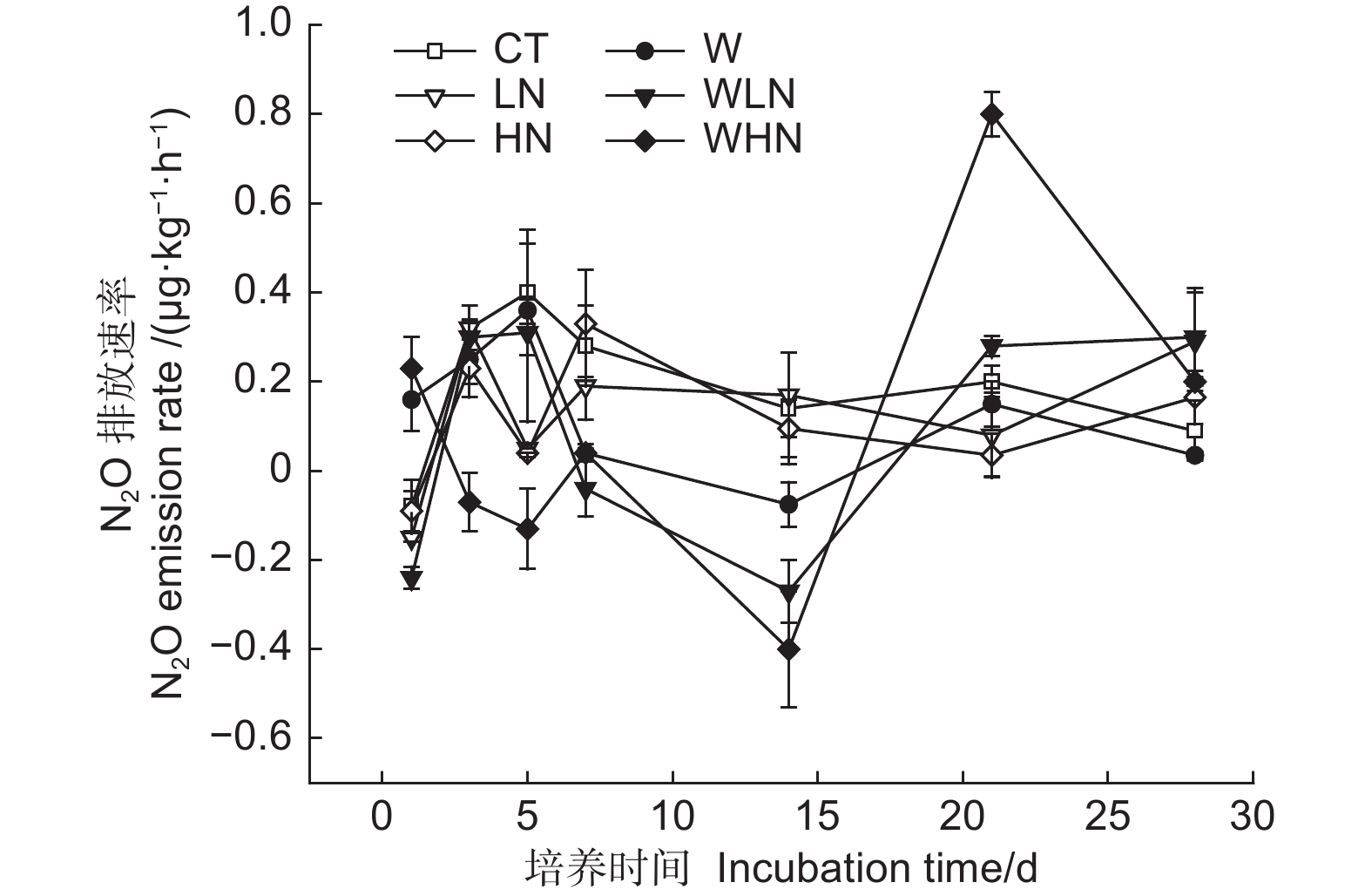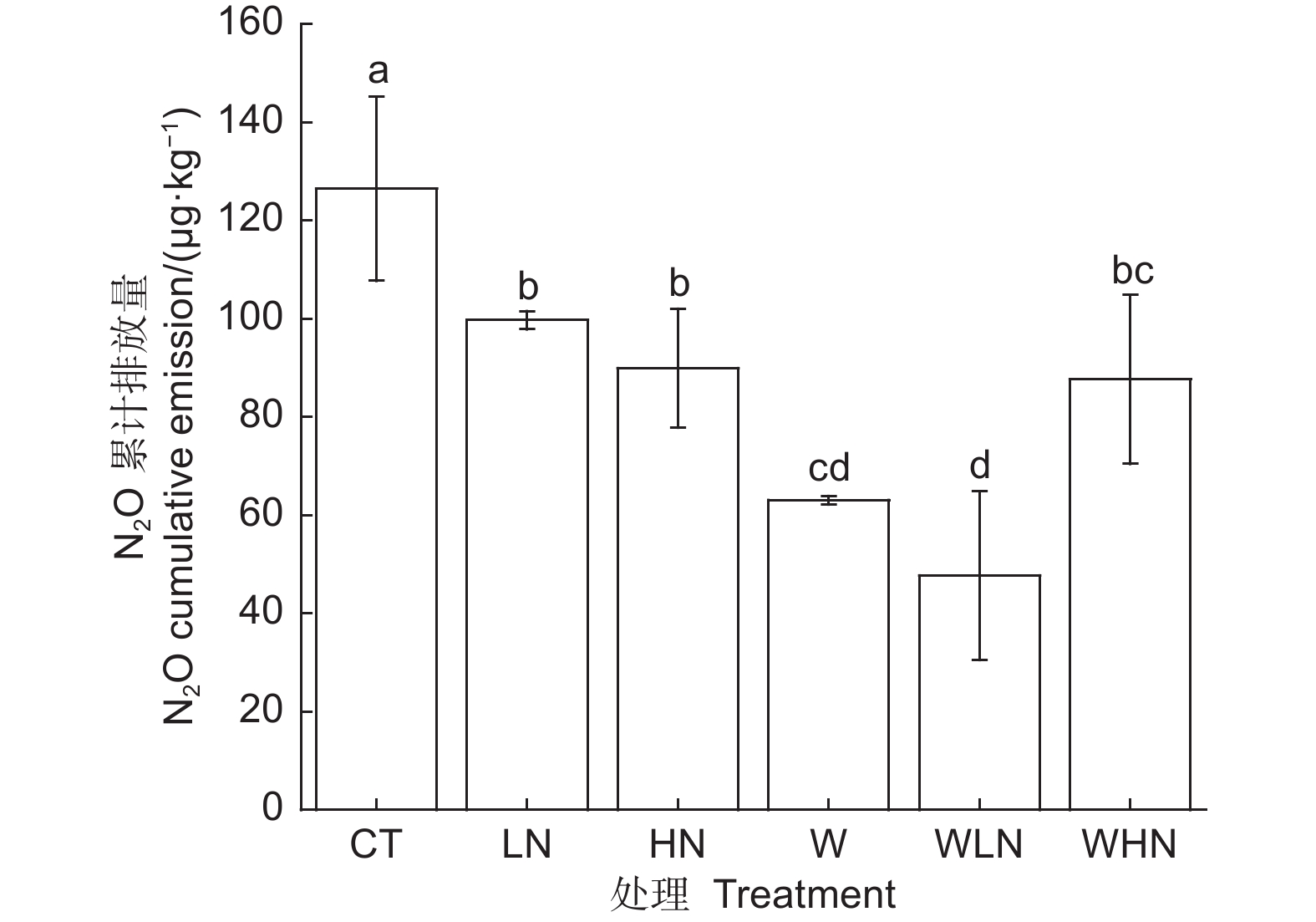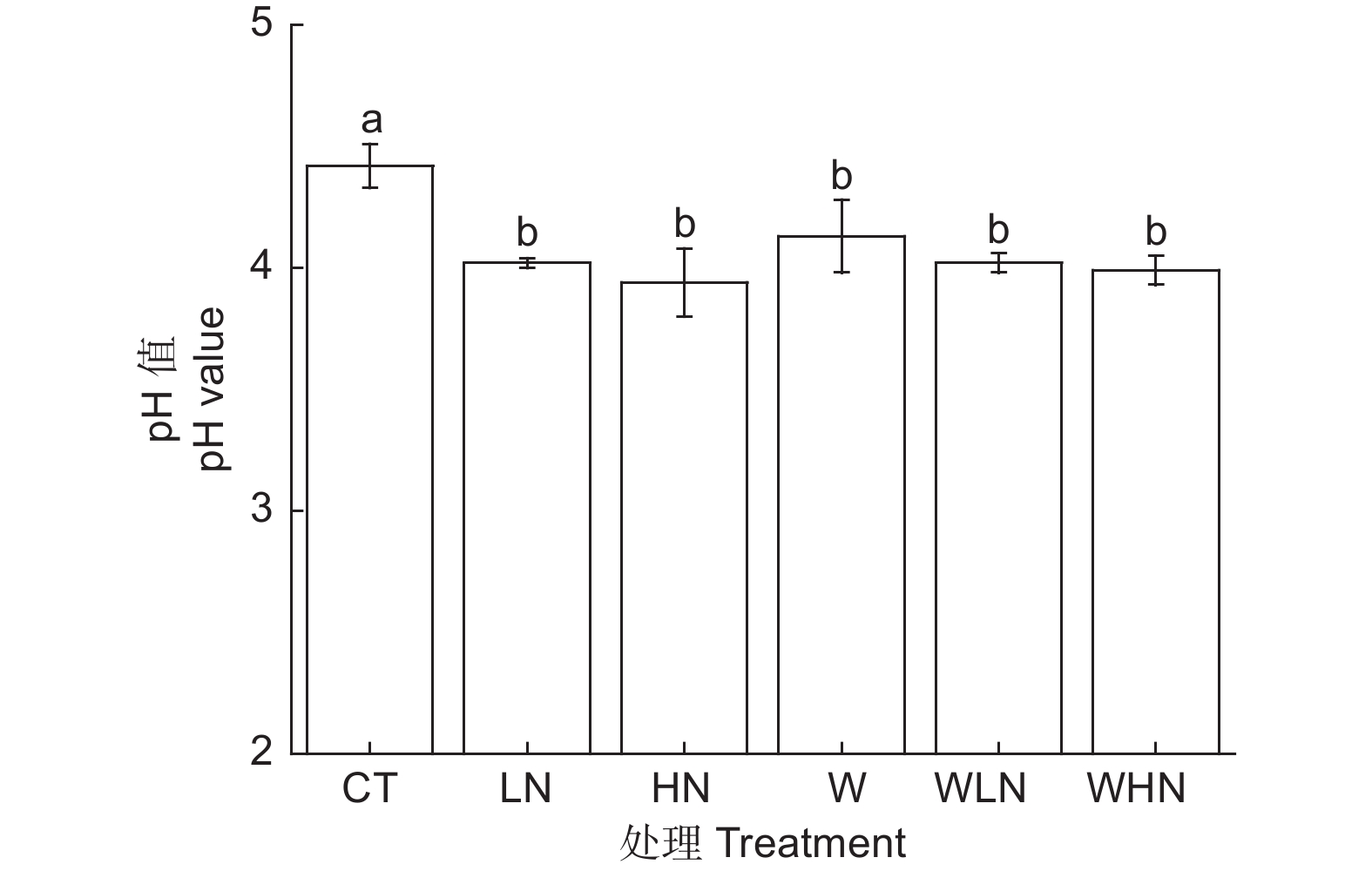-
增温和氮沉降是驱动全球变化的2个重要因素。IPCC第六次评估报告中多个气候模型预测表明,未来气候仍将呈变暖趋势,相比于1850—1900年,2081—2100年全球表面平均温度将升高大约4.4 ℃[1]。人类活动导致氮沉降比例增加,由氮沉降引发的一系列环境问题已逐渐成为当今研究热点。研究指出,中国是全球氮沉降最严重的地区之一[2],其中,我国亚热带地区氮沉降量高达40 kg·hm−2·a−1[3]。土壤氮素是陆地生态系统的重要养分元素,同时也是植物生长所需的营养元素。自然界中的氮通常需要由微生物分解成简单无机氮如铵态氮和硝态氮,这个过程称为土壤氮矿化[4]。土壤氮矿化产生的铵态氮和硝态氮在土壤中进一步转化产生N2O。全球变化通过改变微生物分泌的胞外酶活性、微生物生物量以及微生物群落结构间接影响土壤氮矿化过程[5-8],从而对森林生态系统生产力产生深远影响。此外,森林土壤作为重要的温室气体N2O排放源,其巨大的排放潜能对调节全球气候十分重要[9]。因此,研究森林土壤氮矿化和N2O排放对增温和氮添加的响应具有重要意义。
温度是影响土壤氮矿化的重要环境因子,通常认为一定范围的增温会促进微生物对有机氮的矿化,因为温度升高提高土壤中微生物及其分泌的胞外酶活性 [5-6]。Butler等[10]在温带北方森林进行长达7 a的增温5 ℃实验发现,温度升高使土壤净氮矿化每年平均增加45%。此外,有研究发现,土壤氮矿化速率随温度增加呈先升高后降低的趋势,并在25 ℃时土壤氮矿化速率达到最大[11]。与此同时,土壤氮矿化过程受氮添加的直接作用,氮添加往往会促进土壤氮矿化[12]。然而,目前有关氮添加对亚热带土壤氮矿化的影响仍未达成一致观点。相比于温带北方地区,通常认为亚热带地区土壤氮有效性高,外源氮的持续输入可能导致亚热带地区土壤出现氮富集现象,导致土壤pH值降低,影响土壤微生物量、微生物多样性和群落结构等[8, 13-14],进而改变土壤氮矿化速率,引起土壤氮素的排放和淋溶[15]。此外,氮添加对土壤氮矿化作用的程度受氮添加量影响,如Gao等[16]在我国南部亚热带松林进行的氮添加实验发现,低氮添加的土壤氮矿化速率与对照没有显著差异,而高氮添加则降低了20%左右。N2O是一种重要的温室气体,人们越来越关注N2O浓度升高对全球气候变暖和氮循环的影响。同时,气候变暖和氮沉降可能反作用于N2O浓度的变化。如多数研究表明,增温提高了微生物丰度和活性以及增温增加土壤可溶性有机碳(DOC)的输入,促进了N2O排放[17-18];但也有研究指出,增温会减少N2O的排放[19]。增温对土壤N2O排放的影响仍未达成一致观点。有研究指出,氮添加会通过改变土壤pH环境进而作用于土壤N2O排放,如过酸的土壤环境会抑制N2O还原酶的活性[20],从而增加N2O排放。此外,氮添加为硝化反硝化过程提供充足底物,随着氮添加含量升高,N2O排放也明显增加[21]。
综上,这些单因子变化对森林土壤氮矿化及N2O排放的研究表明,森林土壤氮矿化及N2O排放对增温和氮添加的响应表现出复杂的特征,由于不同研究的气候区、养分背景等不同,增温和氮添加对森林土壤氮矿化及N2O排放的影响机制存在差异[13,19,22]。未来全球变化背景下增温和氮沉降将同时发生,然而有关增温和氮添加及二者交互对森林土壤氮矿化和N2O排放的影响研究较少,这不利于清晰认识土壤氮素转化过程中增温和氮添加及二者交互在其中发挥的作用和关系。因此,有必要对中亚热带森林土壤氮矿化和N2O排放进行研究。本研究以中亚热带杉木(Cunninghamia lanceolata (Lamb.)Hook.)人工幼林土壤为研究对象,采用室内培养的方法探究增温和氮添加对土壤氮矿化和N2O排放的影响,为研究全球变化背景下土壤氮循环过程提供基础数据。
-
研究区位于福建三明森林生态系统国家野外科学观测研究站——陈大观测点(26°19′ N,117°36′ E),该区平均海拔300 m,年均气温19.1 ℃,年平均降水量1 749 mm,年平均蒸发量1 585 mm,相对湿度81%,属于中亚热带季风气候,土壤以花岗岩发育的红壤为主[23]。
-
2013年11月,于野外设置对照(CT)、增温(W,﹢5 ℃)、低氮(LN,40 kg·hm−2·a−1)、高氮(HN,80 kg·hm−2·a−1)、增温 + 低氮(WLN)、增温 + 高氮(WHN) 6个处理,每个处理5个重复,共30个2 m × 2 m的试验小区,进行增温和氮添加长期模拟试验。本研究增温设置5 ℃主要根据IPCC第五次气候评估报告和哈佛森林土壤增温实验综合考虑进行设置[24-25]。根据氮添加水平要求,分别称取3.6 g和7.2 g NH4NO3(分析纯)溶解于800 mL去离子水中,于每月月初使用手提式喷雾器在相应氮添加小区中进行均匀喷洒,对照小区喷洒等量的去离子水,全年共12次[26]。增温和氮添加样区具体布设参见文献[27]。
于2015年7月在30个2 m × 2 m的试验小区中采集0~10 cm土层的土样,使用直径3 cm的土钻在每个小区中随机钻取5个点并混合,作为1个小区的土样,共30个土样。采集结束后立即带回实验室处理,拣去土样中的石砾、根系和动植物残体并过2 mm土筛,过筛后的土样用于培养实验。
-
培养实验设置6种处理:对照(CT)、增温(W)、低氮(LN)、高氮(HN)、增温 + 低氮(WLN)和增温 + 高氮(WHN)。称取每个试验小区新鲜土样(相当于10 g干土质量)平铺于240 mL培养瓶中,往培养瓶内的土壤表面滴加去离子水,均匀滴加至土壤饱和持水量的60% (WHC),用保鲜膜封闭瓶口,同时在膜上扎等数量小孔以保持培养瓶内通气良好,将培养瓶置于20 ℃培养箱中预培养4 d。4 d预培养结束后,对野外不同处理的土样继续进行相应的处理。具体而言,对野外进行氮添加处理的土样继续添加相应浓度的NH4NO3溶液,经换算室内培养低氮和高氮添加量分别为0.1 g·kg−1和0.2 g·kg−1的NH4NO3溶液,使土壤含水量达到60%WHC,同时对野外对照和增温处理的土样添加去离子水至60%WHC。将对照、低氮和高氮处理的培养瓶置于20 ℃培养箱内培养,增温、增温 + 低氮和增温 + 高氮处理的培养瓶置于25 ℃培养箱内培养,共146个培养瓶(6个处理 × 24个重复 + 2个空白)。测定每个处理中任意3个重复的矿质氮含量,作为试验起始值。于黑暗环境中培养28 d,每隔5 d采用称重法补充瓶内水分,使土壤含水量始终保持60%WHC。在培养的第1、3、5、7、14、21、28天,对每个处理随机选取3个培养瓶进行抽气。抽气前先用生料带将瓶口螺纹处缠绕和盖上瓶盖,然后将培养瓶置于培养箱培养,2 h后将培养瓶取出,用注射器采集10 mL气体并注入40 mL气袋中用于测定N2O浓度。每次抽气结束后,土壤用于测定矿质氮含量。
-
样品N2O浓度由气相色谱仪测定。采用2 mol·L−1的KCl溶液浸提土壤矿质氮(铵态氮 + 硝态氮),上清液采用连续流动分析仪(SKALAR SAN + + ,荷兰)测定铵态氮和硝态氮含量[28];土壤pH值按土水比1:2.5混合,然后用pH计测定。
-
各矿质氮矿化速率分别按下列公式计算[29]:
NMR= [ (NH4 + –N + NO3––N)t – (NH4 + –N + NO3––N)t0]/ (t–t0)
NAR= [ (NH4 + –N)t – (NH4 + –N)t0]/ (t–t0)
NR= [ (NO3––N)t – (NO3––N)t0]/ (t–t0)
式中:NMR为土壤净矿化速率、NAR为土壤净铵化速率,NR为土壤净硝化速率,t为培养的天数,t0为第0天。
N2O排放速率按下列公式计算[30]:
F=M/Vm × V/m × Δc/Δt × 273/ (273 + T)
式中:F表示N2O排放速率(N, μg·kg−1·h−1);M为N2O的摩尔质量(44 g·mol−1);Vm为标准状况下1 mol气体的体积(22.4 L·mol−1);V为培养瓶体积(m3);m为培养土的干土质量(kg);Δc/Δt为在2 h内气体浓度随时间变化的直线斜率;T为培养箱温度( ℃);F为正值时表示土壤排放N2O,为负值时表示土壤吸收N2O。N2O累积排放量由相邻2次气体平均排放速率和排放时间相乘并累加得到。
-
采用线性函数拟合、单因素方差分析和重复测量方差分析方法对数据进行分析,利用SPSS 22.0软件进行统计分析,通过Origin 9.0软件制图,图表数据为平均值 ± 标准误,显著性水平设定为P<0.05。
-
由图1可知:各处理的土壤铵态氮含量、硝态氮含量和矿质氮含量均表现为增温 + 高氮>高氮>低氮>增温 + 低氮>增温>对照,与对照处理相比,单独氮添加、增温和氮添加交互处理明显提高了土壤铵态氮含量、硝态氮含量和矿质氮含量,而增温处理增加不明显,说明氮添加能显著增加土壤矿质氮含量,且氮添加水平越高土壤矿质氮含量增加越明显,增温处理增加土壤矿质氮含量的效果比氮添加小。单独氮添加、增温和氮添加交互处理的土壤铵态氮含量在培养第1天和第3天达到最大值,土壤硝态氮含量在第14天达到最大值,说明单独氮添加、增温和氮添加交互处理增加的铵态氮可能一部分通过硝化作用转化为硝态氮。增温处理的土壤铵态氮含量、硝态氮含量和矿质氮含量随培养时间的增加呈上升趋势,并在培养结束时达到最大值,说明增温处理对土壤矿质氮的影响存在时间滞后性,增温时间越长,增加的矿质氮含量就越明显。单独氮添加、增温和氮添加交互处理的土壤铵态氮含量随培养时间延长呈不断减少的趋势,但仍比对照处理的高,土壤硝态氮含量在培养期间波动较大,变化趋势为先升高后降低再升高。表1表明:氮添加、培养时间及二者交互处理显著影响土壤铵态氮含量、硝态氮含量和矿质氮含量,培养时间也显著影响土壤净铵化速率、净硝化速率和净氮矿化速率,且氮添加与培养时间存在显著交互作用。此外,单独氮添加、增温和氮添加交互处理对土壤净氮矿化速率影响显著(P<0.05)。
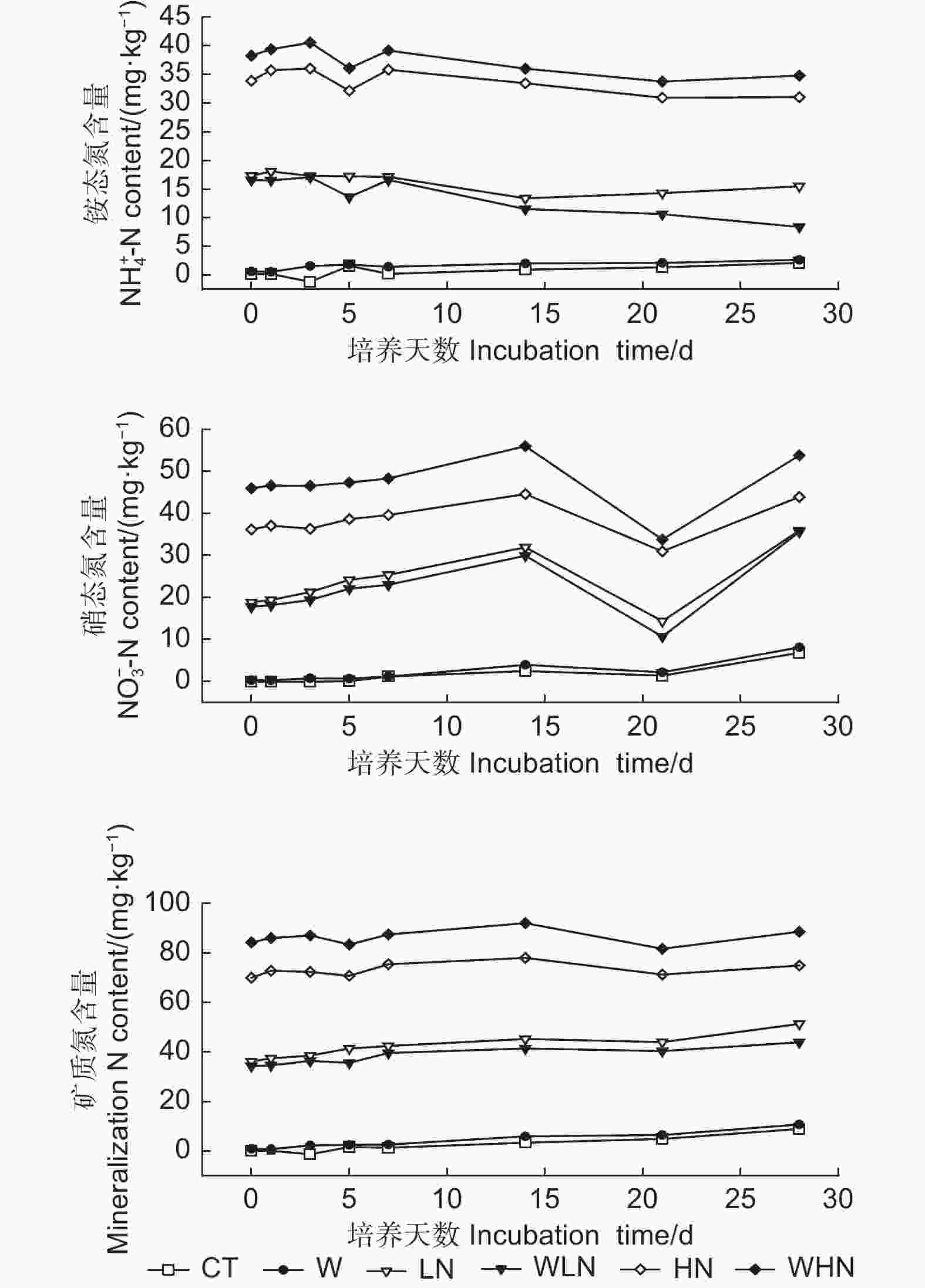
Figure 1. Changes of soil ammonium, nitrate and mineral nitrogen contents with time under warming and nitrogen addition treatments
由图2可知:与对照相比,单独增温处理对土壤净铵化速率、净硝化速率和净氮矿化速率影响不显著(P>0. 05),单独氮添加、增温和氮添加交互处理显著降低土壤净铵化速率,而低氮和增温 + 低氮处理显著提高了土壤净硝化速率(P<0.05)。此外,低氮处理显著提高土壤净氮矿化速率,而高氮和增温 + 高氮处理显著降低土壤净氮矿化速率(P<0. 05)。

Figure 2. Effects of warming and nitrogen addition on soil net ammoniation rate, net nitrification rate and net nitrogen mineralization rate after 28 days of incubation
由图3可知:主成分1(PC1) 和主成分2(PC2) 对土壤净铵态氮转化的解释率分别为64.4%和21.5%,2轴的累积贡献率为85.9%(图3a);PC1和PC2对土壤净硝态氮转化的解释率分别为78.0%和16.3%,2轴累积贡献率为94.3%(图3b);PC1和PC2对土壤净氮矿化的解释率分别为46.4%和40.4%,2轴累积贡献率为86.8%(图3c)。单独氮添加、增温和氮添加交互处理均与对照处理间隔距离较远,即对照处理能明显的与这几种处理区分开,说明单独氮添加、增温和氮添加交互处理使土壤净铵态氮转化(图3a)、土壤净硝态氮转化(图3b)和土壤净氮矿化(图3c)发生明显变化;其中,高氮和增温 + 高氮处理对土壤净铵态氮转化、土壤净硝态氮转化和土壤净氮矿化的影响较一致,而低氮和增温 + 低氮处理对土壤净硝态氮转化的影响较一致。
-
增温、培养时间、增温 × 氮添加、增温 × 培养时间、氮添加 × 培养时间、增温 × 氮添加 × 培养时间均显著影响土壤N2O排放速率(P<0.05),而氮添加对土壤N2O排放速率无显著影响(表1)。图4表明:单独增温处理土壤N2O排放速率整体低于对照处理,在第5天单独增温处理土壤N2O排放速率达最高值0.36 μg·kg−1·h−1。0~5 d,与对照相比,氮添加处理降低了土壤N2O排放速率,且高氮处理降低的土壤N2O排放速率较低氮处理明显。低氮和高氮处理土壤N2O排放速率分别在第3天和第7天达到最高值,分别为0.32和0.33 μg·kg−1·h−1。整体上看,前14 天增温和氮添加交互处理土壤N2O排放速率低于对照处理,并在第14天达到最低值,随后土壤N2O排放速率逐渐升高,增温 + 低氮处理土壤N2O排放速率在第21天超过对照处理,并在第28天达到最高,增温 + 高氮处理的N2O排放速率最高值在第21天出现。
处理
Treatment铵态氮含量
NH4+-N
content硝态氮含量
NO3−-N
content矿质氮含量
Mineralization
N content净铵化速率
Net
ammonification
rate净硝化速率
Net
nitrification
rate净氮矿化速率
Net nitrogen
mineralization
rateN2O排放速率
N2O
emission
rate增温
Warming0.885 0.605 0.744 0.659 0.801 0.718 < 0.001 氮添加
Nitrogen addition< 0.001 < 0.001 < 0.001 0.656 < 0.001 < 0.001 0.114 增温 × 氮添加
Warming × Nitrogen addition0.954 0.724 0.887 0.218 0.709 0.028 0.031 培养时间
Incubation time< 0.001 < 0.001 < 0.001 < 0.001 < 0.001 < 0.001 < 0.001 增温 × 培养时间
Warming × Incubation time0.112 0.056 0.185 0.281 0.321 0.089 < 0.001 氮添加 × 培养时间
Nitrogen addition × Incubation time< 0.001 < 0.001 0.018 0.001 < 0.001 0.001 0.001 增温 × 氮添加 × 培养时间
Warming × Nitrogen addition ×
Incubation time0.463 0.935 0.946 0.007 0.894 0.622 0.027 Table 1. Repeated measures analysis of variance for the effects of warming, nitrogen addition and incubation time on soil mineralization nitrogen, nitrogen transform and N2O emission rates
图5表明:增温、低氮、高氮、增温 + 低氮和增温 + 高氮处理土壤N2O累积排放量显著低于对照处理,分别降低50%、21%、29%、62%和31%;单独增温处理土壤N2O累积排放量显著低于氮添加处理,增温 + 高氮处理土壤N2O累积排放量显著高于增温 + 低氮处理。
-
图6表明:室内培养28 d后,增温和氮添加处理土壤pH值较对照处理显著降低(P<0.05),但增温和氮添加处理间土壤pH值无显著差异。
-
由图7可知:土壤N2O排放速率与土壤净铵化速率无显著相关性(R2=0.03, P=0.30),与净硝化速率呈显著负相关(R2=0.11, P=0.03),而与土壤pH呈显著正相关(R2=0.72, P=0.03)。
-
温度升高通常提高微生物的生理活性,从而促进土壤有机氮的分解释放,因此,温度升高会增加土壤矿质氮的含量。本研究中,单独增温处理较对照处理增加了土壤铵态氮、硝态氮和矿质氮含量,这与Bai等[5]的研究结果一致。有研究显示,增温对氮矿化的促进作用仅限于一定温度范围(5~25 ℃),超过25 ℃,氮矿化速率则随着温度的升高而降低[31],这与本试验培养温度设置为25 ℃提高了土壤氮矿化的结果一致,说明本研究25 ℃的培养温度能最大程度促进微生物活性。唐海龙等[11]研究也发现,25 ℃时土壤氮矿化速率达到最大。培养时间对土壤矿质氮含量有显著影响(表1),随培养时间的延长单独增温处理的土壤矿质氮含量呈上升趋势,在培养结束时达到峰值(图1),说明在适宜的增温环境中,培养时间越长,微生物活性保持在一个较活跃的范围就越能充分分解有机氮,从而增加土壤中的有效氮含量。
本研究发现,单独氮添加对土壤铵态氮、硝态氮和矿质氮含量有显著影响(表1)。与对照相比,单独氮添加处理增加了土壤铵态氮、硝态氮和矿质氮含量(图1),这与赵文君等[32]对喀斯特原生乔木林土壤氮矿化的研究结果一致。表明氮添加能直接增加土壤矿质氮含量,提高了微生物活性和增强了微生物对有机物的矿化,进而产生较多的矿质氮[33]。此外,增温和氮添加交互处理也增加土壤矿质氮含量(图1),这与刘志江等[34]的研究结果一致。温度升高提高了微生物活性,而氮添加为微生物生长繁殖直接提供了大量有效氮,这进一步刺激了土壤氮矿化过程,增加土壤矿质氮含量[11, 35]。在室内培养实验中,酸性土壤中的铵态氮通常由微生物通过硝化作用转化为硝态氮或被微生物自身利用,形成微生物生物量氮[36]。本研究中,单独氮添加、增温和氮添加交互处理的土壤铵态氮含量在培养前期很快达到最大值,而土壤硝态氮含量达最大值的时间滞后于土壤铵态氮含量,在培养中后期出现峰值(图1),说明单独氮添加、增温和氮添加交互处理增加的铵态氮可能一部分通过硝化细菌的作用转化为硝态氮。
氮添加显著影响土壤净硝化速率(表1),培养28 d后,低氮、增温 + 低氮处理的土壤净硝化速率显著高于对照(图2)。此外,氮添加及其与增温交互处理对土壤净氮矿化速率有显著影响(表1)。与对照处理相比,低氮处理显著提高土壤净氮矿化速率,而高氮、增温 + 高氮处理显著降低土壤净氮矿化速率(图2)。主成分分析结果也显示,对照处理能明显的与单独氮添加处理、增温和氮添加交互处理区分开(图3)。原因是:一方面氮添加能抑制土壤微生物腐殖质降解酶的产生,从而降低土壤氮矿化速率[37];另一方面,氮添加还会通过改变土壤有机质化学键结构而降低了胞外酶活性及其衰变速度。因此,尽管氮添加使矿质氮含量增加(图1),但同时也改变了微生物分解有机质的能力和降低了土壤氮矿化速率[38]。增温和氮添加交互处理中,氮添加的影响是主要原因。Cheng等[39]研究指出,土壤微生物氮矿化对外源氮输入的响应存在阈值。亚热带地区土壤氮富集,过高的氮添加会使土壤酸化,pH值降低,从而改变微生物活性,影响土壤氮矿化[13]。这可能是本研究不同浓度氮添加对土壤净氮矿化速率有显著差异的原因。
-
温度升高通常会促进土壤N2O排放,王小鸽等[40]在秦岭温带森林进行的增温实验表明,增温增加土壤N2O排放量,这与本研究结果不一致。本研究中,单独增温处理显著影响土壤N2O排放(表1),与对照相比,单独增温处理整体降低土壤N2O排放速率(图4),N2O累积排放量也显著减少(图5),这可能是由于温度升高限制了微生物对磷养分的利用。本样地前期研究发现,增温通过影响土壤微生物对磷的利用显著抑制了反硝化作用进而减少土壤N2O排放[41]。这表明在氮有效性充足而磷有效性不足的中亚热带地区,增温不利于土壤N2O排放。Cui等[42]研究发现,N2O排放量与土壤NO3−呈正相关,NO3−的增加导致N2O排放增加,这与本研究结果不一致。尽管单独氮添加处理显著增加土壤硝态氮含量(P<0.05)(图1),但土壤N2O排放速率和累计排放量均较对照处理降低,其中,低氮和高氮处理土壤N2O累积排放量分别显著降低21%和29%(P<0.05)(图5)。这可能与氮添加通过降低土壤pH改变了调控N2O产生(nirS和nirK)和还原( nos Z Ⅰ和nos Z Ⅱ)的基因比值有关。邓米林等[43]研究指出,高氮处理通过降低土壤pH值间接降低(nirS + nirK)/( nos Z Ⅰ + nos Z Ⅱ)值,从而降低N2O排放潜势。本研究中,单独氮添加处理显著降低土壤pH值,高氮和低氮处理的pH值分别为3.94和4.02(图6)。较低的土壤pH除了通过调控N2O产生和还原的微生物基因,还使土壤可溶性有机质被强烈吸附导致土壤可溶性有机质减少,进而影响N2O的产生[43-45]。与对照相比,增温和氮添加交互处理的土壤N2O排放整体降低(图4),土壤N2O累积排放量也减少(图5);Yuan等[46]在本样地的研究指出,增温和氮添加交互处理显著降低表层土壤溶液的可溶性有机碳浓度。Bárta等[47]在酸性森林土壤中研究发现,nirK反硝化菌的数量与pH值和DOC之间存在指数相关性,分别显示出2个重要的阈值(pH值为5,DOC为4.8 mol·kg−1),土壤pH值和DOC低于这2个值,nirK反硝化菌的数量会急剧减少。因此,可以推测,本研究增温和氮添加交互处理可能通过降低土壤pH值和DOC含量减少nirK反硝化菌数量进而抑制N2O排放。Zhang等[48]研究发现,土壤N2O排放情况与土壤pH值有关,在酸性土壤中,土壤N2O排放随pH值升高而增多,这与本研究结果一致。本研究供试土壤采自中亚热带红壤区,土壤pH值在4左右(中性土壤pH值为7),为酸性土壤,土壤N2O排放速率与土壤pH呈显著正相关(图7),这说明土壤pH值在酸性土壤N2O排放中发挥着重要作用。
-
增温和氮添加及二者交互处理不同程度影响中亚热带森林土壤氮转化。氮添加、增温和氮添加交互处理明显增加土壤铵态氮、硝态氮和矿质氮含量,并随氮添加量增加而增加,增温处理增加不显著。氮添加及其与增温交互处理增加的土壤铵态氮可能一部分转化为硝态氮。不同浓度氮添加处理的土壤氮矿化存在差异,低氮处理促进土壤氮矿化,而高氮、增温 + 高氮处理抑制土壤氮矿化。增温、氮添加及二者交互处理整体抑制了土壤N2O排放,且显著降低土壤N2O累积排放量。此外,土壤净硝化速率与土壤N2O排放速率呈显著负相关,与土壤净铵化速率无显著相关。可见,未来增温和氮沉降背景下,中亚热带森林土壤氮素可能会伴随降水淋溶流失而不是以气态形式排放。
Effects of Warming and Nitrogen Addition on Soil Nitrogen Mineralization and N2O Emission in a Mid-subtropical Cunninghamia lanceolata Plantation
- Received Date: 2022-10-06
- Accepted Date: 2023-02-21
- Available Online: 2023-06-20
Abstract:




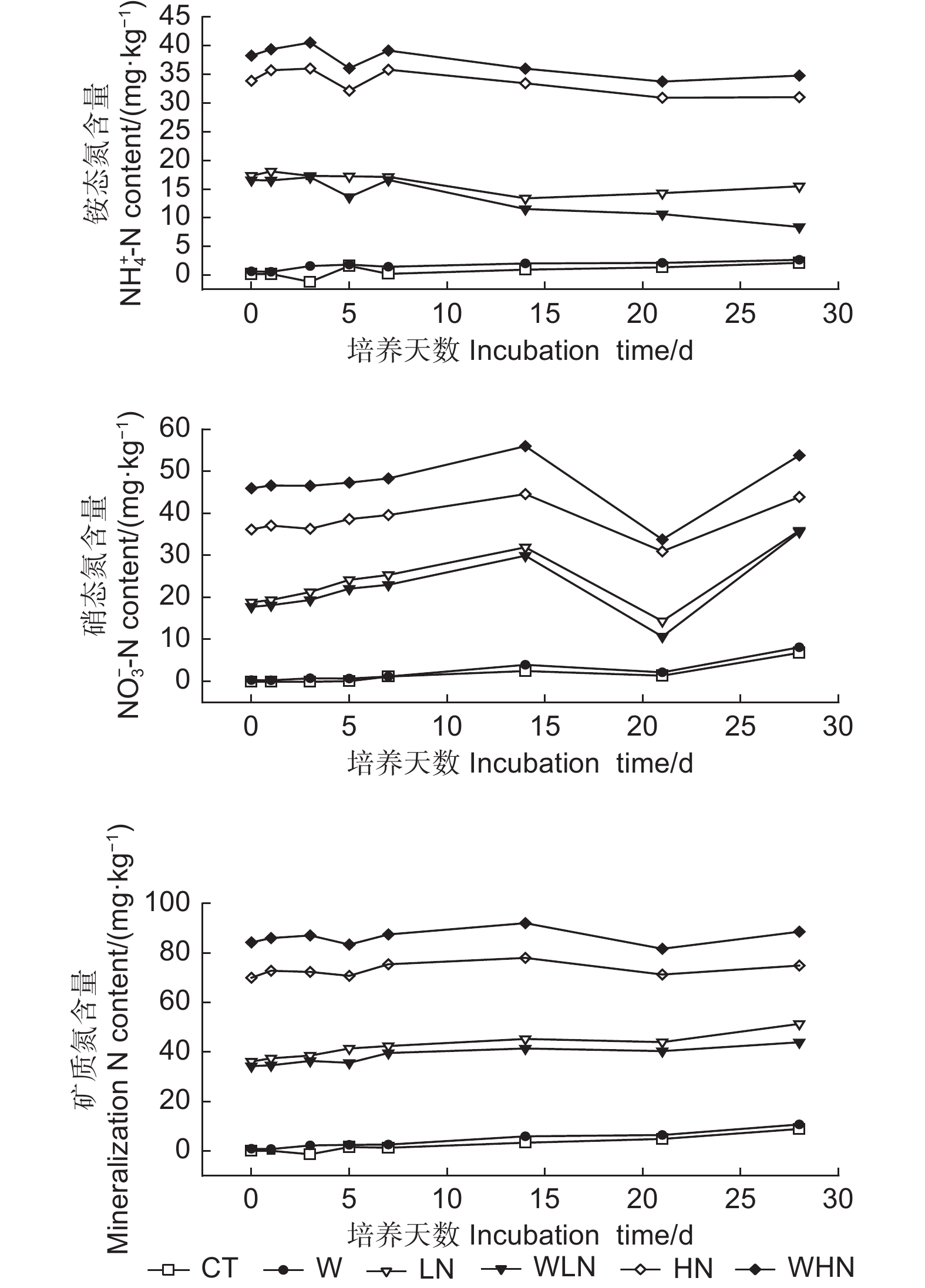


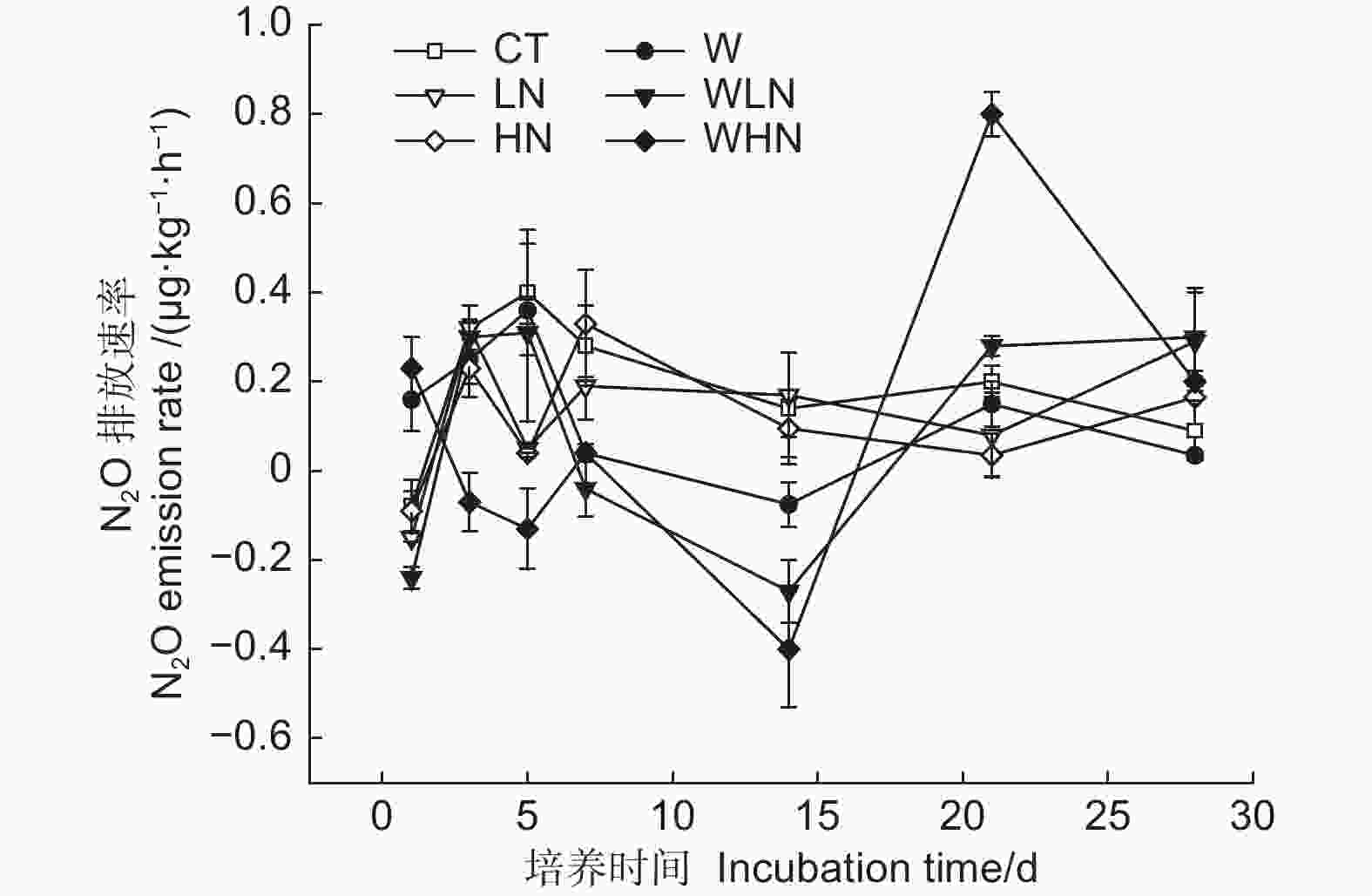
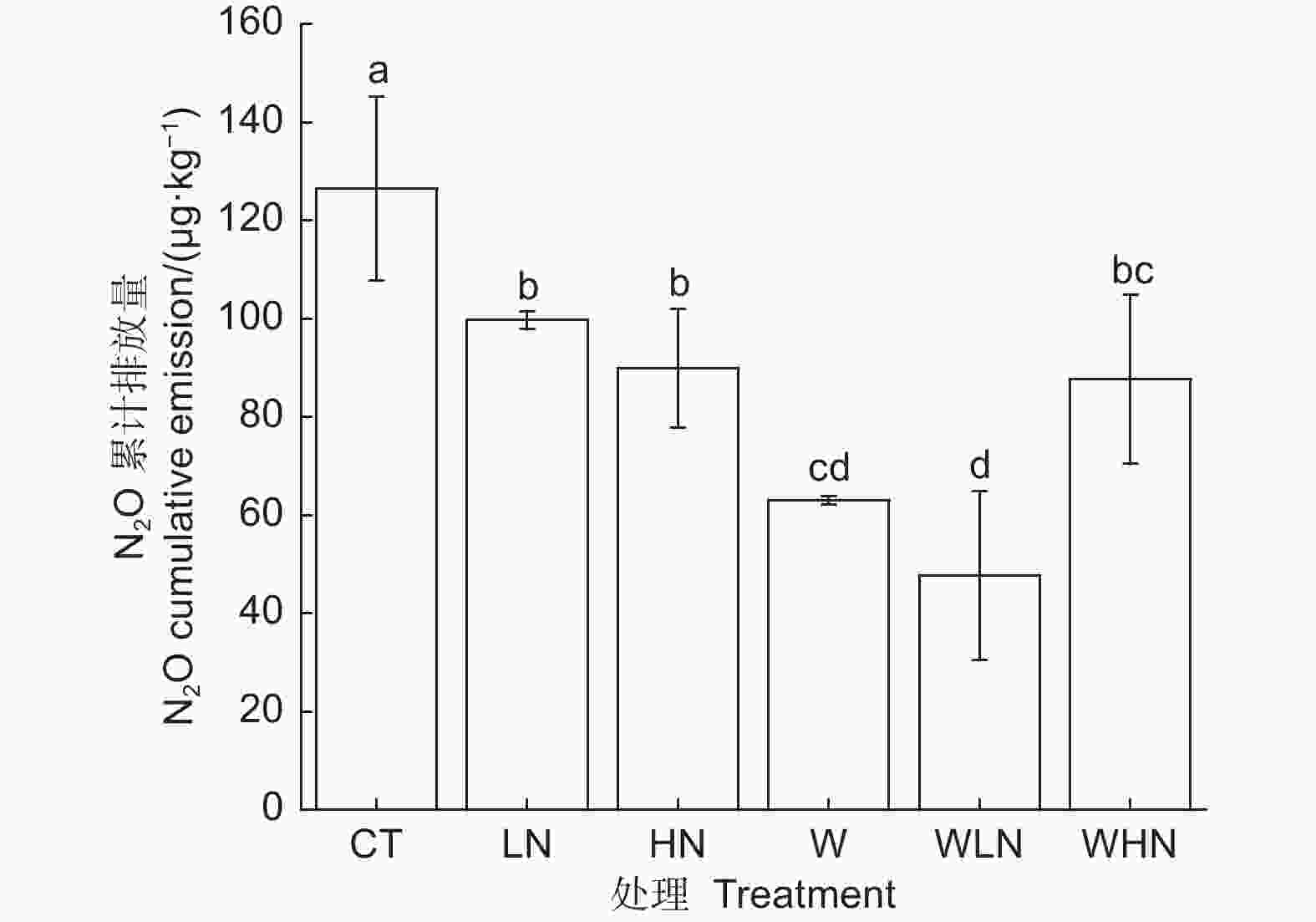
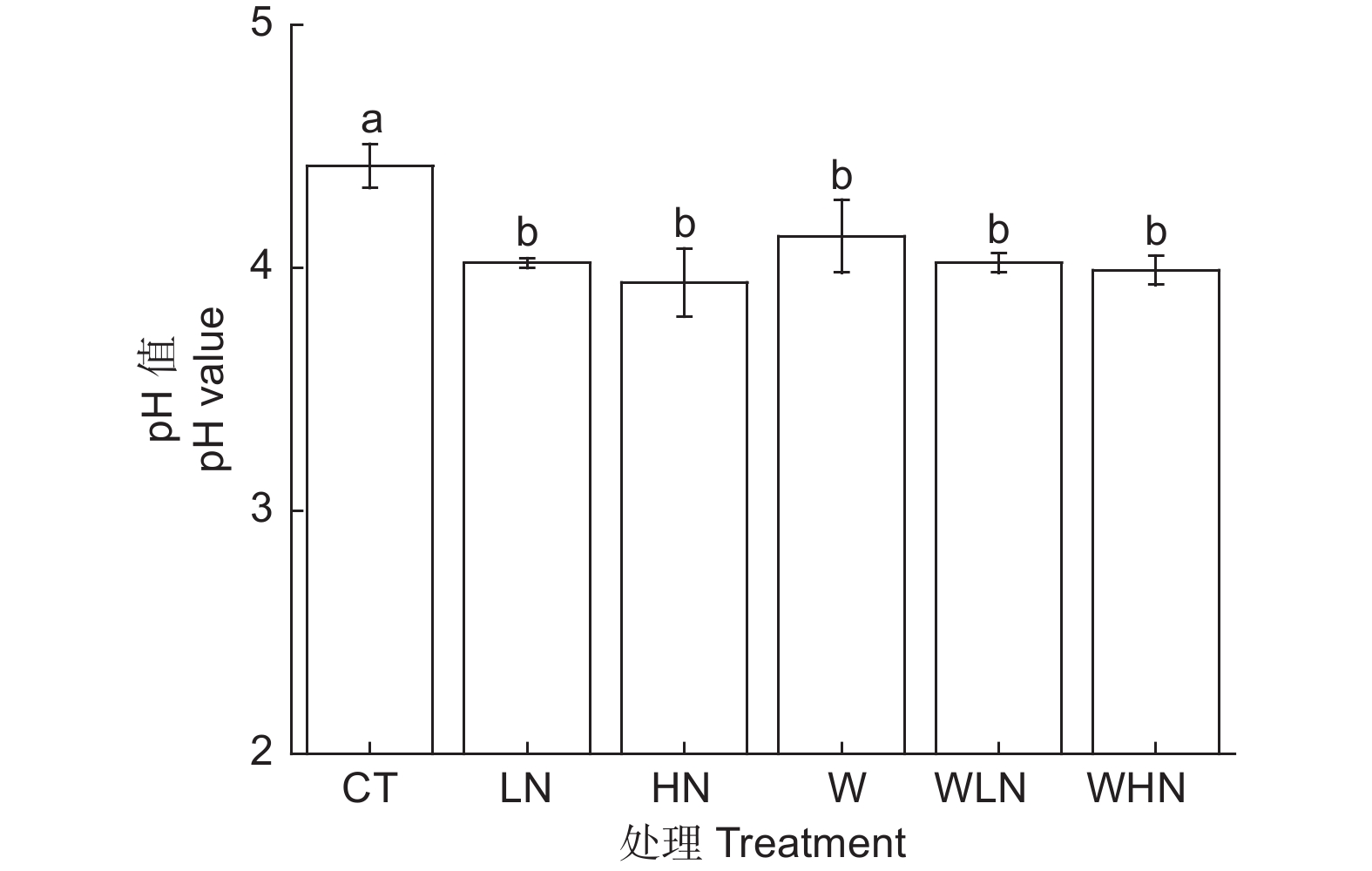

 DownLoad:
DownLoad:


